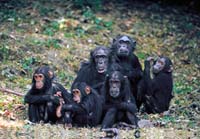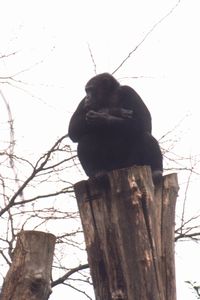Chimpanzee Social Groups

Credit-- Michael Neugebauer
The chimpanzees of Gombe
live in a large social group called a community. At Gombe,
a community may consist of about 50 chimpanzees of which 6
to 8 are adult males and usually twice as many adult
females (12 to 16). The remaining community members are
infants, juveniles, and adolescents. Community size is
dependent on the availability of seasonal resources such
as food.
A chimpanzee community
may break up into many smaller groups that continue to
change in size and composition (fission-fusion). The most
common small group is a mother and her offspring foraging
for food. Sometimes two or more females with their
offspring meet, eat, rest and play together. Some
individuals may leave the community for several days and
then return
Captive Chimpanzees
Chimpanzees living in zoos generally live in much smaller
groups. Taronga Zoo, located in Mosman, Australia has one
of the largest groups of chimpanzees living together. The
Taronga group is composed of approximately forty
chimpanzees. Like their wild cousins, this chimpanzee
community is a mixture of different ages and sexes. They
can be seen interacting as a social group in their large
varied outdoor enclosure. The group leader of zoo
chimpanzees is also called the "alpha male".
Zoo chimpanzees
recognize and respond to their keepers. They are trained
to enter and exit the out door enclosure and react
appropriately to medical and emergency procedures. Keenly
aware of the public, zoo chimpanzees often find a favorite
spot in the enclosure to view the public and a special
place to get away when the crowds become especially
bothersome.

Credit-Eric Matthews
The Jane Goodall
Institute's ChimpanZoo Program works with zoo staff
members and volunteers to study the behavior and health of
zoo chimpanzees. The program strives to improve zoo
chimpanzees' psychological and physical well-being through
information obtained from research and enrichment. The
ChimpanZoo program also informs and educates the public
about chimpanzee behavior and conservation.


